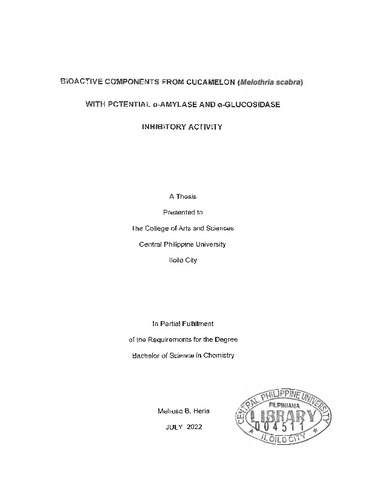Bioactive components from cucamelon (Melothria scabra) with potential α-amylase and α-glucosidase inhibitory activity

Page views
1,034Date
2022-07Auteur
Thesis Adviser
Defense Panel Chair
Share
Metadata
Afficher la notice complète
Résumé
Cucamelons (Melothria scabra) are found growing in the wild in the Philippines. The lack of available literature regarding the plant species prompted to conduct of this study. This study aimed to extract and fractionate bioactive components from cucamelon with potential α-amylase and α-glucosidase inhibitory activity. Cucamelon fruit samples were obtained from Brgy. Pagsanga-an Pavia, Iloilo, extracted with methanol, fractionated using silica column chromatography, and assayed for α-amylase and α-glucosidase inhibitory activity. Results show that most but not all of the fractions have α-amylase inhibitory activity. Only four fractions showed α-amylase activity, namely, acetone (8.97 ± 1.54), acetone: methanol, 4:1 (15.54 ± 2.12), acetone: methanol, 3:2 (11.30 ± 2.51), and acetone: methanol, 1:4 (17.94 ± 2.19). Only one fraction had α-glucosidase inhibitory activity, which is acetone: methanol, 3:2 (3.59 ± 1.10). Cucamelon has a low inhibitory activity for α-amylase and α-glucosidase, enzyme markers of diabetes, which can be compensated by increasing the daily intake. It is recommended that unripe cucamelon fruits can be eaten regularly as salads, or pickled to help prevent the risk of developing diabetes.
Description
Abstract only
Suggested Citation
Heria, M. B. (2022). Bioactive components from cucamelon (Melothria scabra) with potential α-amylase and α-glucosidase inhibitory activity (Unpublished thesis). Central Philippine University, Jaro, Iloilo City.
Type
ThesisKeywords
Department
College of Arts and SciencesDegree
Bachelor of Science in ChemistryShelf Location
Filipiniana Theses 540.72 H423
Physical Description
vii, 40 leaves


